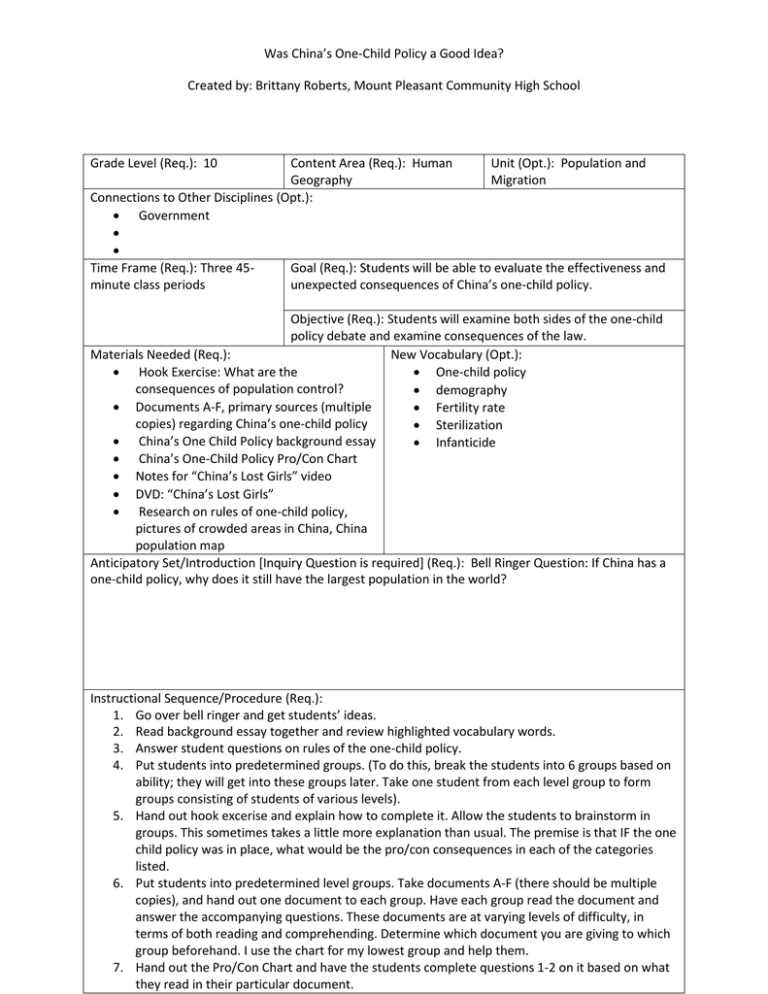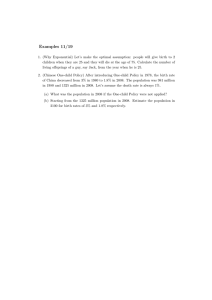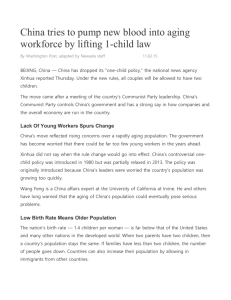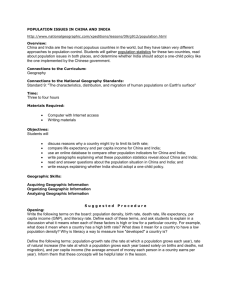Was China’s One-Child Policy a Good Idea?
advertisement

Was China’s One-Child Policy a Good Idea? Created by: Brittany Roberts, Mount Pleasant Community High School Grade Level (Req.): 10 Content Area (Req.): Human Unit (Opt.): Population and Geography Migration Connections to Other Disciplines (Opt.): • Government • • Time Frame (Req.): Three 45Goal (Req.): Students will be able to evaluate the effectiveness and minute class periods unexpected consequences of China’s one-child policy. Objective (Req.): Students will examine both sides of the one-child policy debate and examine consequences of the law. Materials Needed (Req.): New Vocabulary (Opt.): • Hook Exercise: What are the • One-child policy consequences of population control? • demography • Documents A-F, primary sources (multiple • Fertility rate copies) regarding China’s one-child policy • Sterilization • China’s One Child Policy background essay • Infanticide • China’s One-Child Policy Pro/Con Chart • Notes for “China’s Lost Girls” video • DVD: “China’s Lost Girls” • Research on rules of one-child policy, pictures of crowded areas in China, China population map Anticipatory Set/Introduction [Inquiry Question is required] (Req.): Bell Ringer Question: If China has a one-child policy, why does it still have the largest population in the world? Instructional Sequence/Procedure (Req.): 1. Go over bell ringer and get students’ ideas. 2. Read background essay together and review highlighted vocabulary words. 3. Answer student questions on rules of the one-child policy. 4. Put students into predetermined groups. (To do this, break the students into 6 groups based on ability; they will get into these groups later. Take one student from each level group to form groups consisting of students of various levels). 5. Hand out hook excerise and explain how to complete it. Allow the students to brainstorm in groups. This sometimes takes a little more explanation than usual. The premise is that IF the one child policy was in place, what would be the pro/con consequences in each of the categories listed. 6. Put students into predetermined level groups. Take documents A-F (there should be multiple copies), and hand out one document to each group. Have each group read the document and answer the accompanying questions. These documents are at varying levels of difficulty, in terms of both reading and comprehending. Determine which document you are giving to which group beforehand. I use the chart for my lowest group and help them. 7. Hand out the Pro/Con Chart and have the students complete questions 1-2 on it based on what they read in their particular document. 8. Once each group is done with their respective document and with answering questions 1-2, have them get back into their original groups. 9. Once in their groups, they are to be answering #3 (the pro/con chart) on their handout. They do this by going around and sharing the pros/cons from their particular document. The rest of the group writes these ideas down. They should have a bulleted list on each side once each person has gone. 10. The next day, or on the same day if there is time, ask the students what they think about China’s one-child policy. Was it more positive or negative for China? 11. Show the maps/pics that demonstrate how populated and crowded China is. Explain that many people think the one-child policy was good for China because it was needed to decrease the population. 12. Look at article about changes in China’s one-child policy and video clip about couples losing their one child and then having no one to care for them when they are old. 13. Hand out video notes for “China’s Lost Girls.” Go through the questions so the students know what to look for. 14. Watch DVD: “China’s Lost Girls.” 15. Go over main ideas of video. 16. Have students write paragraph explaining their opinion on China’s one-child policy. Have them include at least two specific reasons for their answer. 17. 18. 19. 20. Formative Evaluation (Req.): Collect the written Assessment (Req.): Essay question on unit paragraph at the end of class and provide test: Should poor countries who have feedback for students. traditionally had high birth rates introduce a “one-child policy”? Why or why not? Provide and explain at least 2 specific reasons to support your answer. (Think back to the pros and cons of China’s onechild policy.) Iowa Core Curriculum Standards Used (Req.): • Understand current social issues to determine how the individual is able to formulate opinions and responds to those issues. (SS.9-12.BS.4) • Understand how human factors and the distribution of resources affect the development of society and the movement of populations. (SS.9-12.G.3) • Understand how culture affects the interaction of human populations through time and space. (SS.9-12.G.6) • Understand the effects of geographic factors on historical events. (SS.9-12.H.6) • • • • • • Common Core Curriculum Standards Used (Opt.): • CCSS.ELA-LITERACY.RH.9-10.9: Compare and contrast treatments of the same topic in several primary and secondary sources. • CCSS.ELA-LITERACY.RH.9-10.6: Compare the point of view of two or more authors for how they treat the same or similar topics, including which details they include and emphasize in their respective accounts. • CCSS.ELA-LITERACY.RH.9-10.7: Integrate quantitative or technical analysis (e.g., charts, research • • data) with qualitative analysis in print or digital text. NGS Standards Used (Req.): • Spatial Distribution of Population: » 2.A. Identify and explain how historical, environmental, economic, political, and technological factors have influenced the current population distribution. • • • • • • • • • Five Themes of Geography Used (Req.): • Human Environment Interaction • • • • st 21 Century Universal Constructs (Opt.): Other Disciplinary Standards (Opt.): • • • • • Other Essential Information (Opt.): Other Resources (Opt.): • • • • School District Standards and Benchmarks (Opt.): • • • China’s One Child Policy: Was it a Good Idea? 1. In your group, was your document in support of or against China’s one-child policy? 2. What specific evidence in your document led you to your answer to #1? (This is what you will be sharing eventually, so please be detailed enough so that others understand this argument). 3. In the chart below, use the information presented in your second group to compile a list of pros and cons of China’s one-child policy. PROS CONS China’s Lost Girls Video Notes Name: #: 1. Why are there so many female Chinese children adopted into the U.S.? 2. How much does it cost on average to adopt a child from China? 3. Why do couples in China feel they must have a boy? 4. How many baby girls in China are abandoned every year? 5. Where do most of the abandoned girls come from? 6. What happens if couples have more than one child in China? 7. How many more young boys are there than girls, according to officials? 8. Why is the growing gender imbalance between boys and girls causing concern? What problems could it cause? 9. How is the government trying to change people’s views of/actions toward girls? 10. What surprising trend is occurring that many attribute to people spoiling their one child?



